|
|
|
Sort Order |
|
|
|
Items / Page
|
|
|
|
|
|
|
| Srl | Item |
| 1 |
ID:
101869
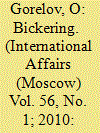

|
|
|
|
|
| Publication |
2010.
|
| Summary/Abstract |
WHY DO RUSSIA AND POLAND remain in an antagonistic embrace for far too long, and in defiance of common sense? Why are the past mistakes still alive? What is behind this and who is the gainer? This is not idle curiosity: the questions should be answered. Indeed, Russia's relations with Poland's EU and NATO neighbors are good or even model, to borrow an expression from our recent past.
|
|
|
|
|
|
|
|
|
|
|
|
|
|
|
|
| 2 |
ID:
120373
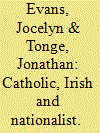

|
|
|
|
|
| Publication |
2013.
|
| Summary/Abstract |
Irish national identity, political nationalism and Catholicism are the defining characteristics of the minority community in Northern Ireland. These identifiable ethno-national and ethno-religious characteristics have been the basis of communal solidarity that has transcended increasing socio-economic heterogeneity within that community. Both of the Nationalist political parties in Northern Ireland, Sinn Féin and the Social Democratic and Labour Party (SDLP), draw their support almost exclusively from their community of origin. What is not known, however, is the relative importance of Irishness, Catholicism and Nationalism in shaping support for either party. Which of these ethnic identifiers is of greatest salience in identifying support for Sinn Féin or the SDLP? Drawing upon recent election survey evidence, this article attempts to rectify this information deficit, highlighting the weighting of components of ethnicity in determining intra-bloc political allegiances.
|
|
|
|
|
|
|
|
|
|
|
|
|
|
|
|
| 3 |
ID:
178363
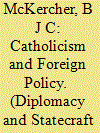

|
|
|
|
|
| Summary/Abstract |
Esme Howard, the British diplomat posted to the Paris Peace Conference to handle policy towards North and Northeastern Europe, saw his proposals except for the Polish Corridor largely ignored by David Lloyd George, the prime minister, and his advisors at Downing Street. The two men had decidedly different conceptions of post-war Poland: Howard plumped for a large Poland with adequate territory and economic resources to counter the certain revival of Britain’s adversaries Germany and Russia; Lloyd George looked for a smaller one to appease republican Germany and Russia whether the latter became ‘Red’ or ‘White’. It has been suggested that as Howard was Roman Catholic, he looked to support reborn Roman Catholic Poland as much as he could. Such assertions are incorrect. Before and after 1919 in his various postings, he always put British interests above all else, even in Catholic countries in which he served. His advice at Paris was to ensure smaller Powers like Poland and the Baltic States could with British support maintain a regional balance of power against Britain’s Berlin and Moscow. Lloyd George lacked any strategic vision in seeking to ameliorate differences with the Germans and Russians.
|
|
|
|
|
|
|
|
|
|
|
|
|
|
|
|
| 4 |
ID:
129193
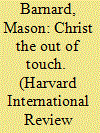

|
|
|
|
|
| Publication |
2014.
|
| Summary/Abstract |
A majestic, powerful figure, Christ the Redeemer stands far above the Brazilian city of Rio De Janeiro-a physical manifestation of the power and authority of the Catholic Church. Upon its completion in 1931, the statue symbolized the hope and prosperity of Catholicism in Latin America. But no longer. In the slums and favelas below Christ's welcoming embrace, fewer and fewer turn towards the Catholic faith for solace.
Protestantism and similar, more liberal Christian sects continue to grow across the region-a result of long term demographic changes. A wide variety of missionary groups, primarily Evangelicals from North America, arrive each year to successfully spread the faith in areas with little influence from the church or the state. Over 50,000 Evangelicals ar- rive in Honduras alone each year. Without social services, missionaries fulfill a critical role in providing infrastructural
|
|
|
|
|
|
|
|
|
|
|
|
|
|
|
|
| 5 |
ID:
096842
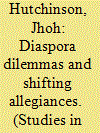

|
|
|
|
|
| Publication |
2010.
|
| Summary/Abstract |
Focused on the London Irish, this article discusses the diasporic dilemmas of Irish Catholics in England who oscillated between four claims to loyalty in the early twentieth century. Liberals and later the labour movement sought to mobilise them for radical political and socialist goals; the Catholic Church to support religious education against secularist threats; a homeland nationalism to advance the prospects of Irish parliamentary autonomy; and a diasporic nationalism to defend their ethnic interests in England. These pressures peaked during the First World War and the Irish War of Independence. The overall effect of this nationalist mobilisation may have been to advance their integration into English social and political institutions.
|
|
|
|
|
|
|
|
|
|
|
|
|
|
|
|
| 6 |
ID:
193601
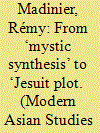

|
|
|
|
|
| Summary/Abstract |
Since the 1990s, Indonesia has been confronted with the growing influence of a radical Islamist movement that challenges the state doctrine (Pancasila), which was adopted in 1945, and demands a greater place for Islam, which is the religion of nearly 90 per cent of the population. The hardline groups wish to call into question the Indonesian state’s pluralistic and inclusive religious identity, which they see as a conspiracy hatched by the Christian minority to deprive the Muslim majority of its ostensible rights. The Society of Jesus, which has been present in Java since the nineteenth century, is considered by Islamist critics as the main architect of this alleged plot. Furthermore, one of its members, Father Josephus Beek, is presented by Islamist radicals as one of the founders of the New Order (1966–1998), the regime led by General Suharto which was very hostile to political Islam in its early days. This article analyses how the Society of Jesus was able to integrate Catholicism into the Javanese spiritual landscape and explores the subsequent roles played by Jesuit leaders in the genesis and defence of Pancasila. It also sheds light on how Josephus Beek’s very real manoeuvres have provided fodder for militant Islamist circles seeking to delegitimate Indonesia’s secular status quo.
|
|
|
|
|
|
|
|
|
|
|
|
|
|
|
|
| 7 |
ID:
136296


|
|
|
|
|
| Summary/Abstract |
Sri Lankan Catholic migrants find Italy to be a destination that offers plenty of opportunities for material advancement. However, as employment for skilled workers is scarce, lack of formal education becomes a comparative advantage in the Italian migrant labor market. The multiple ways in which migrants to Italy display their economic success across Sri Lankan hometowns have encouraged young people to opt for migration over schooling, an unlikely phenomenon in a community proud of its tradition of excellence in education. This article suggests that the dream of moving to Italy and finding employment in low-paying jobs is not only a consequence of the material evidence provided by successful migrants. Ideological and ethical changes that precede the booming transnationalism have produced transformations at the level of the imagination that shape the dreams of local youths before they experience what migration can bring. Fieldwork research is based in the predominantly Catholic town of Wennappuwa – which has uncannily embraced the Sinhala moniker of Punchi Italia (Little Italy) – and explores the way in which migration has displaced traditional paths to economic prosperity and social mobility, leaving behind its reputation as Sri Lanka's Guru Gama (Teacher's Village).
|
|
|
|
|
|
|
|
|
|
|
|
|
|
|
|
| 8 |
ID:
094368
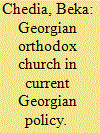

|
|
|
| 9 |
ID:
191043
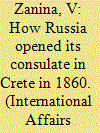

|
|
|
|
|
| Summary/Abstract |
RUSSIA has done a lot to help Greece become an independent state, providing decisive and freely given aid to the people of Greece to save Greek lives and protect Greek interests over the centuries. This is a fact of history. Russian diplomats who served in the Greek provinces of the Ottoman Empire spared no effort to support and encourage Orthodox Christian Greeks. These diplomats did so not only in their line of duty but out of their own convictions and sympathy toward coreligionists. The work of the Russian consulate that opened in Crete in 1860 is one the best examples of the above. Russian diplomats saved Cretan Christians from extermination, prevented their conversion to Catholicism, and thus preserved the canons of Orthodoxy in Crete...
|
|
|
|
|
|
|
|
|
|
|
|
|
|
|
|
| 10 |
ID:
137510


|
|
|
|
|
| Summary/Abstract |
The history of Islam and Indonesian nationalism has been one of constant contestation and acquiescence. Although a new openness in discussing Islamic issues has emerged within Indonesia since President Suharto’s rule came to an end, past logics of national cohesion have not dissipated and have in fact contributed to the upheaval over the Ahmadiyya’s position as Indonesian Muslims and Indonesians. Exploring Indonesian Identification Cards (Kartu Tanda Penduduk, otherwise known as KTP), which currently require every applying Indonesian citizen to self-identify with one of six religious options: (1) Islam; (2) Christianity; (3) Catholicism; (4) Hinduism; (5) Buddhism; and (6) Confucianism, I argue that despite the 2008 Indonesian Joint-Ministerial Decree categorizing the Ahmadis as deviant Muslims, KTP offers the group an opportunity to publically declare and receive official recognition of their Muslim identity from the Indonesian government. Thus, a situation has emerged in which contradictory governmental action problematizes religious categories and illuminates the paradoxical nature of Indonesian nationalism.
|
|
|
|
|
|
|
|
|
|
|
|
|
|
|
|
| 11 |
ID:
127801
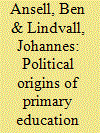

|
|
|
|
|
| Publication |
2013.
|
| Summary/Abstract |
This paper is concerned with the development of national primary education regimes in Europe, North America, Latin America, Oceania, and Japan between 1870 and 1939. We examine why school systems varied between countries and over time, concentrating on three institutional dimensions: centralization, secularization, and subsidization. There were two paths to centralization: through liberal and social democratic governments in democracies, or through fascist and conservative parties in autocracies. We find that the secularization of public school systems can be explained by path-dependent state-church relationships (countries with established national churches were less likely to have secularized education systems) but also by partisan politics. Finally, we find that the provision of public funding to private providers of education, especially to private religious schools, can be seen as a solution to religious conflict, since such institutions were most common in countries where Catholicism was a significant but not entirely dominant religion.
|
|
|
|
|
|
|
|
|
|
|
|
|
|
|
|
| 12 |
ID:
099883
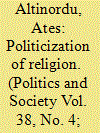

|
|
|
|
|
| Publication |
2010.
|
| Summary/Abstract |
While religious politics have been a widely discussed topic in the social sciences in recent decades, few studies develop general explanations based on systematic and detailed comparative analysis. This article seeks to explain when and how successful religious parties rise. To that end, I comparatively analyze the politicization of German Catholicism in the second half of the nineteenth century (1848-1878) and Turkish Islam in the post-1970 period (1970-2002) and briefly examine the negative case of nineteenth-century German Protestantism. According to the theory of revival-reaction-politicization I propose, successful religious parties rise when major religious revivals confront social counter-mobilization and state repression, provided that existing political parties do not effectively represent religious defense. The study's findings challenge the pervasive tendency to treat Christian and Islamic politics as incommensurable.
|
|
|
|
|
|
|
|
|
|
|
|
|
|
|
|
| 13 |
ID:
125213
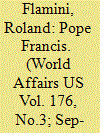

|
|
|
|
|
| Publication |
2013.
|
| Summary/Abstract |
Piled in the storeroom of a leading shoemaker in Rome are several pairs of new, red leather shoes, in different styles and various sizes and half-sizes. Among them are the shoes intended for the new Fisher of Men of the Roman Catholic Church, Pope Francis. But the freshly minted pontiff immediately dispensed with the tradition of wearing red shoes, preferring to keep his sturdy, well-worn black cap toes. He also rejected the ermine-trimmed, elbow-length red cape worn by popes before him, buttoned down the front, and known as a mozzetta; and he kept his own iron pectoral cross in preference to the offered gold one. When the former Cardinal Jorge Mario Bergoglio, lately archbishop of Buenos Aires, appeared for the first time on the balcony of St. Peter's Basilica on a rainy March 13th evening, he wore the white papal cassock and, speaking good Italian, told the huge crowd that the cardinals in the conclave had chosen him "from almost the end of the world."
|
|
|
|
|
|
|
|
|
|
|
|
|
|
|
|
| 14 |
ID:
137282


|
|
|
|
|
| Summary/Abstract |
THE UKRAINIAN STORM of 2013-2014 pushed the world dangerously close to Cold War II. The coup and the bloodshed which swept the country were caused by the refusal of the Yanukovich regime to draw closer to the EU no matter what rather than by the fairly acute social, economic and political disagreements inside the country.1 The consecutive packages of anti-Russian sanctions imposed by the European Union and coordinated, to a great extent, with the U.S. and several other non-European allies look very logical in the context of the stalled dialogue between the two key European players. It was in 2012-2013 that many of the expert community recognized an absence of a more or less noticeable progress in moving toward a visa-free regime between the EU and Russia and in settling other important bilateral issues for what it really was: the EU's unwillingness to develop equal partnership with Russia rather than technical discrepancies (according to Brussels). Its attention was riveted to the Eastern Partnership program designed, among other things, to detach CIS countries from Russia and draw new dividing lines in Europe. Is it correct to say that the anti-Russian rhetoric heard from Brussels and its active support of the radical Ukrainian nationalists who came to power in Kiev through an armed coup buried the Greater Europe idea? What is Greater Europe?
|
|
|
|
|
|
|
|
|
|
|
|
|
|
|
|
| 15 |
ID:
096244
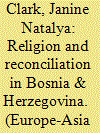

|
|
|
|
|
| Publication |
2010.
|
| Summary/Abstract |
The article explores the question of whether and how religion is being used in Bosnia & Herzegovina (BiH) to promote and foster reconciliation. Based primarily on 20 semi-structured interviews with representatives of the three main faiths in BiH-Islam, Orthodoxy and Catholicism-the article's central contention is that religion is a potentially valuable, yet fundamentally under-utilised peace-building tool in BiH.
|
|
|
|
|
|
|
|
|
|
|
|
|
|
|
|
| 16 |
ID:
131833
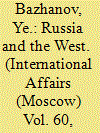

|
|
|
|
|
| Publication |
2014.
|
| Summary/Abstract |
IS RUSSIA A PARTNER of the West? This question has been repeatedly asked throughout centuries both in Russia and in the West. In the 13th century, German crusaders, with the Pope's blessing, invaded the Baltics and pushed further on to Russia, seeking political and spiritual domination. In Russia, this created a rift between those who wanted to draw closer to the West and those who saw it as a deadly threat to the unique East Slavic Orthodox civilization. The crusaders were pushed back, while Russia throughout three more centuries was learning, first unwillingly and later much more consciously, to associate itself with the Tatar-Mongol khans, the conquerors who came from the East.
|
|
|
|
|
|
|
|
|
|
|
|
|
|
|
|
| 17 |
ID:
097834
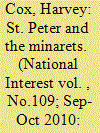

|
|
|
|
|
| Publication |
2010.
|
| Summary/Abstract |
URBI ET Orbi ("for the city and for the world") is the traditional blessing the pope offers on special occasions. Although he has at times pronounced it in other venues-St. John Lateran, the pope's official ecclesiastical seat, or the Quirinale, now the Italian president's residence-the pontiff usually intones the prayer from the balcony overlooking St. Peter's Square. The ancient ceremony reminds us that the pope holds office as head of the Church because he has been elected bishop of "the city," Rome; that he is the leader of a global organization whose very name, "Catholic," means universal (making the whole world his parish); and that he is the head of a miniscule but internationally recognized sovereign state.
|
|
|
|
|
|
|
|
|
|
|
|
|
|
|
|
| 18 |
ID:
103111
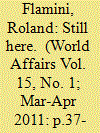

|
|
|
| 19 |
ID:
114661


|
|
|
|
|
| Publication |
2012.
|
| Summary/Abstract |
This essay argues that the building of Angelo da Fonseca's critical fortune as a Christian artist from the 1930s to the 1950s was simultaneously and necessarily the building of his later misfortune and oblivion as a modern artist. Angelo da Fonseca was characterised as a Catholic painter during the first half of the twentieth century after the advice to 'paint churches' purportedly given to him by Rabindranath Tagore (or perhaps his nephew, Abanindranath Tagore). At the time, there was a generalised movement for the creation of a new Christian art involving many artists from all over the world. They too have vanished from art history's printed memory. This was due to modernism's exclusion of Christianity as a subject, which made it impossible for historians and critics to deal with twentieth-century Christian art. This, it will be argued, eventually led to a further exclusion: Indian Christian art was seen as simultaneously un-modern and un-Indian and was, therefore, omitted from the process played by the arts in India's nation-building.
|
|
|
|
|
|
|
|
|
|
|
|
|
|
|
|
| 20 |
ID:
131862
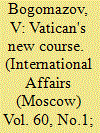

|
|
|
|
|
| Publication |
2014.
|
| Summary/Abstract |
ON MARCH 13, 2013, the conclave of the cardinals of the Roman Catholic Church surprised the world by electing Archbishop of Buenos Aires Jorge Mario Bergoglio as a new Pope. What looked as unexpected and unpredictable is emerging as a deliberate and calculated choice. The cardinals intended to renew and rejuvenate Catholicism, to make it more dynamic and more flexible and, in general, better suited to the globalized world brimming with threats and challenges. The task of this scope and this importance was entrusted to a hierarch who is not young or even middle-aged - he is 76.
|
|
|
|
|
|
|
|
|
|
|
|
|
|
|
|
|
|
|
|
|